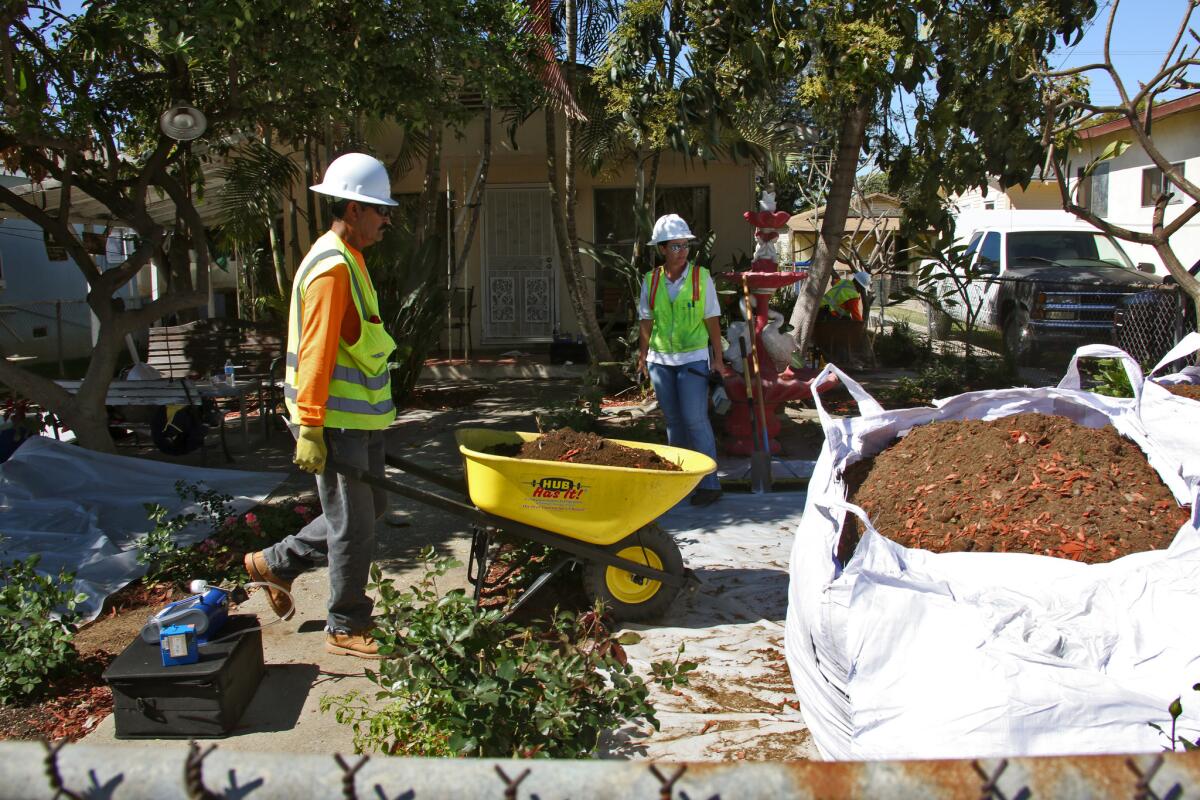Lead contamination found at up to 10,000 southeast L.A. County homes

Workers remove topsoil in March from homes in Boyle Heights that may have been contaminated by lead that possibly came from Exide Technologies, a battery recycling plant in Vernon.
Soil testing has found that lead contamination from a Vernon battery recycling plant extends over a much larger area than previously estimated, possibly reaching as many as 10,000 homes in southeast Los Angeles County, state environmental officials said Friday.
The California Department of Toxic Substances Control had previously estimated a few hundred homes in Boyle Heights and Maywood would require cleanup after decades of air pollution from the now-closed Exide Technologies facility.
The department now believes that the facility’s lead emissions tainted soil up to 1.7 miles downwind, potentially requiring a much more expensive cleanup of 5,000 to 10,000 properties, director Barbara Lee said in a conference call with reporters.
The preliminary results are based on soil samples taken from 146 properties spread across a two-square mile area, including Boyle Heights, Maywood, Huntington Park and East Los Angeles, which were used to model what concentrations are likely to exist at thousand of other homes.
Though the tests found other metals that are markers of Exide’s emissions, the primary concern is lead, a potent neurotoxin that can cause developmental problems in children and has no safe level of exposure.
The department’s higher estimates were a worrisome validation for community leaders who for years fought for the plant’s closure and cleanup.
“The surprise was that it took officials so much time to come to this conclusion,” said Msgr. John Moretta of Resurrection Catholic Church in Boyle Heights. “The bad news is: Where is the money going to come from to clean this up?”
With potentially thousands more homes requiring lead removal, doing so could now cost tens or even hundreds of millions of dollars, far more than the $9 million the department had earmarked for removing soil from about 200 homes and yards closest to the facility.
The disclosure of widespread soil contamination raises questions about whether state and federal authorities will be able to secure enough funds to pay for a more extensive cleanup.
In a deal struck in March with the U.S. attorney’s office, Exide agreed to pay at least $50 million to demolish and clean the 15-acre facility and remove lead contamination from nearby homes. The agreement allowed Exide and its employees to avoid criminal charges for years of releasing dangerous pollutants into the community.
In a statement, Exide said that on Wednesday it submitted to the Department of Toxic Substances Control its own analysis of the soil sampling results, concluding that soil contamination from its Vernon plant is limited.
“The area of impact from the Exide facility above background levels is confined to the industrial area that surrounds the facility and does not reach residential areas,” according to the conclusions of a study by Mitchell Small, a professor at Carnegie Mellon University the company hired to estimate the contribution of its facility’s lead emissions relative to other sources.
Beyond industrial areas “there is no consistent trend in lead concentrations, moving away from the Exide facility, as would be expected if Exide was the source of all lead in the residential area,” Exide’s statement read.
The smelter had operated in Vernon since 1922 and was taken over by Exide in 2000, melting down lead from used batteries to reuse as raw materials for new car batteries.
California officials allowed the facility to operate for 33 years with only a temporary permit, even as it racked up dozens of serious environmental law violations for releasing pollution into the air, soil and water.
Community outrage mounted in 2013, when a report released by the South Coast Air Quality Management District found that Exide’s arsenic emissions posed an increased cancer risk to 110,000 people who live near the facility.
For community members and activists, the latest news was further confirmation of the shortcomings of the toxic substances department, whose oversight of hazardous substances has been harshly criticized statewide in recent years.
“We’re looking at a massive public health disaster that has largely resulted from the state’s utter regulatory failure,” said Gladys Limon, an attorney for the advocacy group Communities for a Better Environment.
The toxic substances department, which is supervising the cleanup under a separate agreement with Exide, has overseen the cleanup of 146 of 217 homes in Boyle Heights and Maywood that air modeling had shown were most likely to be affected by Exide’s emissions.
A year ago, the department expanded testing to an additional 146 homes extending outward over a two-square-mile area of southeast Los Angeles County.
Results on those additional properties were released in April and shared during community meetings in May, Lee said. But the estimates of widespread contamination were not available until an additional metals analysis was completed in July.
Lee first revealed that thousands of homes could be contaminated at a closed meeting with community groups late Thursday.
Last month, the toxic substances department issued a report that said more than 8,000 soil samples at 146 properties in the expanded testing area around the Exide plant “did not find any pattern of dangerous levels of lead contamination” and “an emergency does not exist.” Only 1% of lead samples were above 1,000 parts per million, the report said.
The toxic substances department removed the two-page report on the testing results from its website two weeks ago after outcry at a July 23 meeting of a community advisory group that was formed earlier this year to monitor the cleanup and closure of the Exide plant.
The department said it removed the document “because it summarizes information in a way that caused concern within the community.”
On Friday, Lee reiterated that no properties had high enough lead levels to require immediate action under the U.S. Environmental Protection Agency’s guidelines.
Lee said she was trying to find money to pay for cleanup even as her department seeks additional funding from Exide and other parties that contributed to the contamination. She did not have an estimate of the cost of expanding the soil removal to potentially thousands of properties, but said “it’s going to be an expensive cleanup.”
For more environmental news, follow @tonybarboza.
MORE ON EXIDE:
Exide closing Vernon plant to avoid criminal prosecution
Regulators detail Exide battery plant closure after decades of pollution
Exide faces a long, costly cleanup of closed Vernon plant
More to Read
Sign up for Essential California
The most important California stories and recommendations in your inbox every morning.
You may occasionally receive promotional content from the Los Angeles Times.











